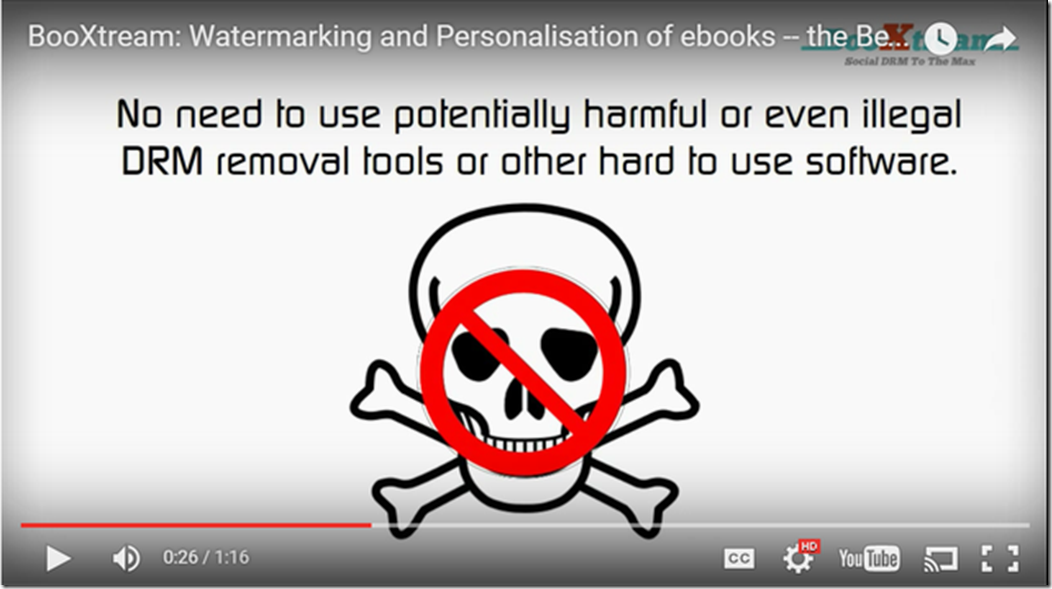Thank to traditional DRM, the typical e-book lover can’t legally modify a “protected” Kindle file for reading in Moon+ Reader Pro. Never mind that Moon+’s features leave Amazon’s Kindles, Fires and apps in the dust, a point that TeleRead community members have picked up on.
Under the Digital Millennium Copyright Act, even if you limit your “piracy”-related activities to enjoyment of Treasure Island, you can’t break DRM if you live in the U.S unless you qualify for a special exemption. Similar legal abominations sully the books, so to speak, in other countries. The legalities can be fuzzy and are still under debate, but due to the DMCA’s horrible anti-circumvention provision, the Digital Media Law Project at Harvard has recommended that Web sites not even point to those with DRM-stripping software. Beyond the legalities, there is the technical challenge of breaking DRM, not to mention the time you waste.
Wouldn’t you rather be able to read your books legally and immediately on whatever reader, tablet or cellphone you want? So just what to do, beyond trying to avoid DRMed books, which can be difficult, given the Big Five’s love of the technology?
The best DRM is none, but as a compromise solution, e-book-lovers should encourage Amazon and the like to offer publishers the option of using social DRM. It gives each copy of a book unique identifiers to discourage piracy. But at the same time social DRM lets books be read on all devices capable of reading the particular format. Moon, as it happens, can read books in Mobipocket and a bunch of other formats. Furthermore, without traditional DRM, it is easier to convert books into a variety of formats so you can enjoy your books by way of the best e-reading hardware or software for you.
Enter the social DRM system that Firebrand Technologies is now making available to publishers as an option for protecting copies of forthcoming books sent to reviewers for newspapers, blogs and elsewhere. I’m delighted to see CEO Fran Toolan and friends going the social DRM route. But I really shouldn’t mention Fran without also talking up BooXtream, a Dutch social DRM company on which author J. K. Rowling has relied to help safeguard Harry Potter books sold through her own Pottermore site. Check out this BooXtream video.
Among other things, BooXtream:
- Offers “visible personalization and multiple invisible watermarks in all data files without sacrificing compatiblity… A publication that has been BooXtreamed can be traced back” to the bookstore “and even to the individual customer.”
- “Doubles as a digital distribution platform by creating and fulfilling download links on the fly. Use your own repository or use the built in BooXtream® repository to store your master files.”
- Is “Mobi compatible.” The BooxTream system can “automatically converts watermarked ePub files to Mobi compatible eBook files for your Kindle users.”
Get the picture? The big question for Amazon and rivals is, “Why aren’t you using a product like BooxTream or Firebrand’s or coming up with your own equivalent? What interests you more—the control-freak act or boosting your revenue by making e-books easier to own for real?” Of course, Amazon and the like would say they need the cooperation of publishers. But given Amazon’s dominance of the e-book market, it could offer better Web site placements, financial inducements or others to publishers of books with either social DRM or no DRM. Doesn’t Google give brownie points to fast-loading sites, especially those which are mobile-friendly? Same idea should apply here. Reward the customer-friendly!
Amazon should not in the least be afraid to use its muscle since this isn’t just a financial issue—it’s a public interest one, and we’re not just talking about more convenience for e-book lovers. Traditional DRM, for example, complicates life for people with disabilities and the need for special e-reading software. Finally, lest you doubt that BooxTream is ready for prime time, keep in mind not only the Pottermore example but also the fact that the company has won the Publishers Weekly International Book Industry Supplier Award.
Granted, BooxTream and similar products can be hacked to remove the identifying marks. But the average consumer just won’t see any reason to do so. And traditional DRM is already quite hackable for pirates, thank you.
Time to write jeff@bezos.com and leaders of other retailers about BooXtream and Firebrand and similar products—or invite them to come up with their own social DRM systems? I see room for many players. One beauty of social DRM is that it is inherently pro-competitive since books published with this technology can be read on a number of devices. And that can only work to the benefit of both e-book-lovers and the publishing industry, or at least within it who understand that E is the real future.
Related: Bertelsmann Random House announces it will drop ‘hard’ DRM on German trade e-books.






























The various publishers that require DRM to be applied to their books claim that they do it to “fight piracy”.
Since pirates are not even inconvenienced by the current DRM schemes, I think that the publishers insist on using DRM for some other reason or reasons; one(s) that they are unwilling to admit to, or discuss openly. I do not, however, think that the executives of major publishing companies are stupid. They apply DRM to their books, which costs them a lot of money, because they believe it is necessary, or in their best interest.
If “Social DRM” is cheaper than what is being used today, and if it provides the same benefit as what is used today (whatever that benefit might be) then the publishers will adopt it. If it isn’t cheaper, and just as good (in the eyes of the publishers) then they won’t adopt it. Appeals from the masses that the publishers do something that they believe is not in their best interest will be ignored.
I just wish that someone at one of the big five publishers would just come right out in the open and explain why they are so hooked on DRM in the first place.
@Gary: Mike Shatzkin surveyed publishers four years back about DRM. Check out his thoughts at http://www.idealog.com/blog/what-the-powers-that-be-think-about-drm-and-an-explanation-of-the-cloud/.
My own preferences is no DRM; but social DRM could really accomplish the same thing that encryption based DRM room does – without inconveniencing users. Apparently some folks at Bertelsmann in Germany agree with me. The world won’t fall apart if the big guys drop traditional DRM. Furthermore, keep in mind that J. K.Rowling is relying on social DRM to discourage piracy of the valuable Potter series, at least the copies sold through her store. Simply put, a lot has changed since Mike’s survey, and I hope that the big Five Publishers in the US catch up with the times.
As for large publishers doing what is logical, however, don’t count on it. If the book industry is so well run, why is the average American household spending less than $35 a year on recreational books compared to the thousands lavished on other forms of entertainment?
Happy New Year,
David
@David
You say: “social DRM could really accomplish the same thing that encryption based DRM room does – without inconveniencing users”.
But what if some publishers use encryption based DRM to DELIBERATELY inconvenience eBook customers, in the hope that eBooks will fade away, and current eBook customers will go back to buying paper books?
High prices, geographic sales restrictions, restrictive DRM, incompatible devices and formats, prohibition of the sale of “used” eBooks… All of these issues affect customers’ buying decisions, and all of them encourage those without a commitment to eBooks to buy paper books instead.
The socially acceptable rationale for DRM is to “fight piracy” but the real reasons are to do with corralling customers and keeping them within an ecosystem that is easy to stay in and hard to leave. This works best for Amazon and the other retailers better than it does for the publishers. Publishers are accustomed to that arrangement – getting a leg up through their retailers. However, with DRM it may not actually work that way. That fact still awaits the dawn of awareness for publishers.
@Gary and @Frank: I agree with both of you. The link at the end of the post, in fact, leads to an earlier one where I said the Big Five were hurting reading in general—not just e-books—by price-gouging digital customers. I would’ve done well to have been more explicit. Yes, the same mindset behind price gouging can in many cases mean an attachment to DRM. Gary did want the DRM justifications given by publishers, however, so I obliged. As for Frank, he is absolutely right about retailers’ walled gardens, which in the end can hurt publishers even if they don’t currently understand the extent to which it does